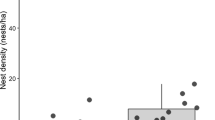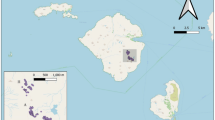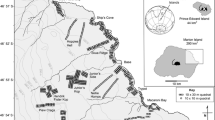Abstract
Whilst there is good evidence for negative impacts of introduced rat species on island ecosystems, the effects of house mice (Mus musculus) are generally less well documented. In some situations, introduced house mice can exert severe impacts, particularly where this is the only introduced mammal. Here, we examine the distribution, relative abundance and breeding success of small burrowing seabirds on Steeple Jason Island, Falklands, in relation to habitat types and the distribution of house mice which is the sole introduced mammal species, and we make comparisons with seabird distribution and densities on the neighbouring island of Grand Jason where mice are absent. Grey-backed storm-petrel (Garrodia nereis) and Wilson’s storm-petrel (Oceanites oceanicus), which due to their extremely small size are likely to be the most vulnerable to mouse predation, were considerably more abundant on mouse-free Grand Jason than on Steeple Jason. Grey-backed storm-petrel, which are typically associated with tussac grass, avoided this habitat on Steeple Jason where it is associated with high levels of house mouse activity (assessed from the proportion of wax baits gnawed overnight), whereas on mouse-free Grand Jason, there was no such avoidance. Wilson’s storm-petrel nesting on Steeple Jason suffered high rates of egg and chick loss. Whilst we found evidence for detrimental impacts of house mice on the two small storm-petrel species, there was no relationship between relative mouse activity levels and the distribution or abundance of the larger thin-billed Prion (Pachyptila belcheri).




Similar content being viewed by others
References
Aebischer NJ (1999) Multi-way comparisons and generalized linear models of nest success: extensions of the Mayfield method. Bird Study 46:522–531
Ainley DG, Henderson RP, Strong CS (1990) Leach’s and ashy storm-petrel. In: Ainley DG, Boekelheide RJ (eds) Seabirds of the Farallon Islands. Stanford University Press, Palo Alto, pp 128–162
Angel A, Wanless RM, Cooper J (2009) Review of impacts of the introduced house mouse on islands in the Southern Ocean: are mice equivalent to rats? Biol Invasions 11:1743–1754
Anon (2009) Steeple Jason and Grand Jason Islands Management Plan 2010–2019. Falklands Conservation and Wildlife Conservation Society, Port Stanley
Baker GB, Gales R, Hamilton S, Wilkinson V (2002) Albatrosses and petrels in Australia: a review of their conservation and management. Emu 102:71–97
Beck JR, Brown DW (1972) The biology of Wilson’s storm-petrel, Oceanites oceanicus (Kuhl), at Signy Island, South Orkney Islands. Br Antarct Surv Rep 69:1–54
Bibby CJ, Burgess ND, Hill DA (1992) Bird census techniques. Academic Press, London
Bicknell TWJ, Reid JB, Votier SC (2009) Probable predation of Leach’s storm-petrel Oceanodroma leucorhoa eggs by St Kilda field mice Apodemus sylvaticus hirtensis. Bird Study 56:419–422
Blackburn TM, Cassey P, Duncan RP, Evans KL, Gaston KJ (2004) Avian extinction and mammalian introductions on oceanic islands. Science 305:1955–1958
Brooke M (2004) Albatrosses and petrels across the world. Oxford University, Oxford
Brown D, Cuthbert RJ (2013) Feasibility Study Report for the potential eradication of mice from Steeple Jason Island, Falkland Islands May 2013. Unpublished report, Royal Society for the Protection of Birds, UK
Burger J, Gochfeld M (1994) Predation and effects of humans on island-nesting seabirds. In: Nettleship DN, Burger J, Gochfeld M (eds) Seabirds on islands: threats, case studies and action plans. BirdLife International, Cambridge, pp 36–67
Butchart SHM (2008) Red List Indices to measure the sustainability of species use and impacts of invasive alien species. Bird Conserv Int 18:S245–S262
Campos JL, Granadeiro JP (1999) Breeding biology of the white-faced storm-petrel on Salvagem Grande Island, north-east Atlantic. Waterbirds 22:199–206
Catry P, Campos A, Segurado P, Silva M, Strange I (2003) Population census and nesting habitat selection of thin-billed prion Pachyptila belcheri on New Island, Falkland Islands. Polar Biol 26:202–207
Catry P, Silva MC, MacKay S, Campos A, Masello J, Quillfeldt P, Strange IJ (2007) Can thin-billed prions Pachyptila belcheri breed successfully on an island with introduced rats, mice and cats? The case of New Island, Falkland Islands. Polar Biol 30:391–394
Copestake PG, Croxall JP (1985) Aspects of the breeding biology of Wilson’s storm-petrel Oceanites oceanicus at Bird Island, South Georgia. Br Antarct Surv Bull 66:7–17
Cuthbert RJ (2002) The role of introduced mammals and inverse density dependent predation in the conservation of Hutton’s shearwater. Biol Conserv 108:67–78
Cuthbert R, Hilton G (2004) Introduced house mice Mus musculus: a significant predator of endangered and endemic birds on Gough Island, South Atlantic Ocean? Biol Conserv 117:483–489
Cuthbert RJ, Louw H, Lurling J, Parker G, Rexer-Huber K, Sommer E, Visser P, Ryan PG (2013) Low burrow occupancy and breeding success of burrowing petrels at Gough Island: a consequence of mouse predation. Bird Conserv Int. doi:10.1017/S0959270912000494
del Hoyo J, Elliott A, Sargatal J (1992) Handbook of the birds of the world volume 1: ostrich to ducks. Lynx Edicions, Barcelona
Fugler SR, Hunter S, Newton IP, Steele WK (1987) Breeding biology of blue petrels Halobaena caerulea at the Prince Edwards Islands. Emu 87:103–110
Hilton GM, Cuthbert RJ (2010) The catastrophic impact of invasive mammalian predators on birds of the UK Overseas Territories: a review and synthesis. Ibis 152:443–458
Howald G, Donlan CJ, Galvan JP, Russell JC, Parkes J, Samaniego A, Wang YW, Veitch D, Genovesi P, Pascal M, Saunders A, Tershy B (2007) Invasive rodent eradication on islands. Conserv Biol 21:1258–1268
Huin N, Reid T (2007) Census of the black-browed albatross population of the Falkland Islands. Falklands Conservation, Stanley
Jones C (2003) Safety in numbers for secondary prey populations: an experimental test using egg predation by small mammals in New Zealand. Oikos 102:57–66
Jones HP, Tershy BR, Zavaleta ES, Croll DA, Keitt BS, Finkelstein ME, Howald GR (2008) Severity of the effects of invasive rats on seabirds: a global review. Conserv Biol 22:16–26
Le Roux V, Chapuis JL, Frenot Y, Vernon P (2002) Diet of the house mouse (Mus musculus) on Guillou Island, Kerguelen Archipelago, Subantarctic. Polar Biol 25:49–57
Marchant S, Higgins PJ (eds) (1990) Handbook of Australian, New Zealand and Antarctic birds, vol 1. Oxford University Press, Oxford
Matias R, Catry P (2008) The diet of feral cats on New Island, Falkland, Islands, and possible impact on breeding seabirds. Polar Biol 31:609–616
Mayfield H (1975) Suggestions for calculating nest success. Wilson Bull 87:456–466
McClelland P, Tyree P (2002) Eradication the clearance of Campbell Island. N Z Geogr 58:86–94
Quillfeldt P (2001) Variation in breeding success of Wilson’s storm-petrel: influence of environmental factors. Antarct Sci 13:400–409
Quillfeldt P, Schenk I, McGill RAR, Strange IJ, Masello JF, Gladbach A, Roesch V, Furness RW (2008) Introduced mammals coexist with seabirds at New Island, Falkland Islands: abundance, habitat preferences, and stable isotope analysis of diet. Polar Biol 31:333–349
Ratcliffe N, Mitchell I, Varnham K, Verboven N, Higson P (2009) How to prioritize rat management for the benefit of petrels: a case study of the UK, Channel Islands and Isle of man. Ibis 151:699–708
Rexer-Huber K, Parker GC, Reeves M, Stanworth AJ, Cuthbert R (2013) Winter ecology of house mice and the prospects for their eradication from Steeple Jason (Falkland Islands). Polar Biol 36:1791–1797
Roberts M (1991) Origin, dispersal routes, and geographic distribution of Rattus exulans, with special reference to New Zealand. Pac Sci 45:123–130
Ryan PG, Cuthbert RJ (2008) The biology and conservation status of Gough Bunting Rowettia goughensis. Bull Br Ornithol Club 128:242–253
Smith VR, Avenant NL, Chown SL (2002) The diet and impact of house mice on a sub-Antarctic island. Polar Biol 25:703–715
St Clair JJH (2011) The impacts of invasive rodents on island invertebrates. Biol Conserv 144:68–81
St Clair JJH, Poncet S, Sheehan DK, Székely T, Hilton GM (2011) Responses of an island endemic invertebrate to rodent invasion and eradication. Anim Conserv 14:66–73
Towns D, Atkinson I, Daugherty C (2006) Have the harmful effects of introduced rats on islands been exaggerated? Biol Invasions 8:863–891
Wanless RM, Angel A, Cuthbert RJ, Hilton GM, Ryan PG (2007) Can predation by invasive mice drive seabird extinctions? Biol Lett 3:241–244
Wanless RM, Ryan PG, Altwegg R, Angel A, Cooper J, Cuthbert R, Hilton GM (2009) From both sides: dire demographic consequences of carnivorous mice and longlining for the critically endangered Tristan albatrosses on Gough Island. Biol Conserv 142:1710–1718
Woods RW (1970) The avian ecology of a tussock island in the Falkland Islands. Ibis 112:15–24
Woods RW, Woods A (1997) Atlas of breeding birds of the Falkland Islands. Anthony Nelson, Oswestry
Acknowledgments
Part of this work was funded by the UK Government’s Darwin Initiative Programme under Grant 18-017 “Developing knowledge to eradicate house mice from UK OT islands” and grant-aided by UK Defra. We thank the Wildlife Conservation Society for permission to work on Steeple Jason and for providing accommodation at the Steinhardt Field Station. We thank WCS warden Rob McGill for considerable logistic support in arranging the visit and for hospitality on Carcass Island. We also thank Mike Clarke, skipper of the Condor, for transport to and from the islands. Thanks also to Craig Dockrill and Farrah Peck for logistic support, and Marilou Delignières and Drew Robertson also provided invaluable assistance with fieldwork.
Author information
Authors and Affiliations
Corresponding author
Rights and permissions
About this article
Cite this article
Bolton, M., Stanbury, A., Baylis, A.M.M. et al. Impact of introduced house mice (Mus musculus) on burrowing seabirds on Steeple Jason and Grand Jason Islands, Falklands, South Atlantic. Polar Biol 37, 1659–1668 (2014). https://doi.org/10.1007/s00300-014-1554-2
Received:
Revised:
Accepted:
Published:
Issue Date:
DOI: https://doi.org/10.1007/s00300-014-1554-2




